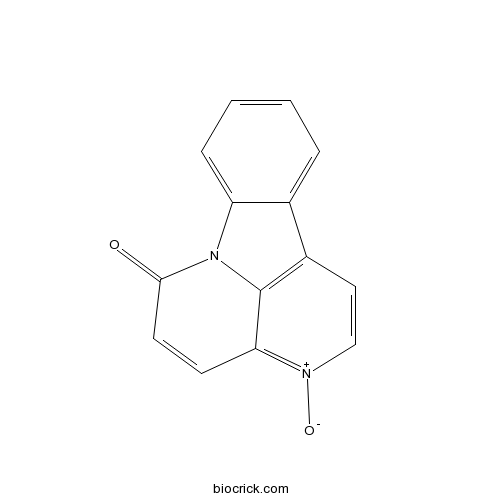Canthin-6-one N-oxideCAS# 60755-87-5 |

Quality Control & MSDS
3D structure
Package In Stock
Number of papers citing our products

| Cas No. | 60755-87-5 | SDF | Download SDF |
| PubChem ID | 9991699 | Appearance | Yellow powder |
| Formula | C14H8N2O2 | M.Wt | 236.2 |
| Type of Compound | Alkaloids | Storage | Desiccate at -20°C |
| Solubility | Soluble in Chloroform,Dichloromethane,Ethyl Acetate,DMSO,Acetone,etc. | ||
| SMILES | C1=CC=C2C(=C1)C3=C4N2C(=O)C=CC4=[N+](C=C3)[O-] | ||
| Standard InChIKey | PMKULNRVYULJPO-UHFFFAOYSA-N | ||
| Standard InChI | InChI=1S/C14H8N2O2/c17-13-6-5-12-14-10(7-8-15(12)18)9-3-1-2-4-11(9)16(13)14/h1-8H | ||
| General tips | For obtaining a higher solubility , please warm the tube at 37 ℃ and shake it in the ultrasonic bath for a while.Stock solution can be stored below -20℃ for several months. We recommend that you prepare and use the solution on the same day. However, if the test schedule requires, the stock solutions can be prepared in advance, and the stock solution must be sealed and stored below -20℃. In general, the stock solution can be kept for several months. Before use, we recommend that you leave the vial at room temperature for at least an hour before opening it. |
||
| About Packaging | 1. The packaging of the product may be reversed during transportation, cause the high purity compounds to adhere to the neck or cap of the vial.Take the vail out of its packaging and shake gently until the compounds fall to the bottom of the vial. 2. For liquid products, please centrifuge at 500xg to gather the liquid to the bottom of the vial. 3. Try to avoid loss or contamination during the experiment. |
||
| Shipping Condition | Packaging according to customer requirements(5mg, 10mg, 20mg and more). Ship via FedEx, DHL, UPS, EMS or other couriers with RT, or blue ice upon request. | ||
| Description | 1. Canthin-6-one N-oxide has broad spectrum antifungal, leishmanicidal and trypanocidal activities. |
| Targets | Antifection |

Canthin-6-one N-oxide Dilution Calculator

Canthin-6-one N-oxide Molarity Calculator
| 1 mg | 5 mg | 10 mg | 20 mg | 25 mg | |
| 1 mM | 4.2337 mL | 21.1685 mL | 42.337 mL | 84.674 mL | 105.8425 mL |
| 5 mM | 0.8467 mL | 4.2337 mL | 8.4674 mL | 16.9348 mL | 21.1685 mL |
| 10 mM | 0.4234 mL | 2.1169 mL | 4.2337 mL | 8.4674 mL | 10.5843 mL |
| 50 mM | 0.0847 mL | 0.4234 mL | 0.8467 mL | 1.6935 mL | 2.1169 mL |
| 100 mM | 0.0423 mL | 0.2117 mL | 0.4234 mL | 0.8467 mL | 1.0584 mL |
| * Note: If you are in the process of experiment, it's necessary to make the dilution ratios of the samples. The dilution data above is only for reference. Normally, it's can get a better solubility within lower of Concentrations. | |||||

Calcutta University

University of Minnesota

University of Maryland School of Medicine

University of Illinois at Chicago

The Ohio State University

University of Zurich

Harvard University

Colorado State University

Auburn University

Yale University

Worcester Polytechnic Institute

Washington State University

Stanford University

University of Leipzig

Universidade da Beira Interior

The Institute of Cancer Research

Heidelberg University

University of Amsterdam

University of Auckland

TsingHua University

The University of Michigan

Miami University

DRURY University

Jilin University

Fudan University

Wuhan University

Sun Yat-sen University

Universite de Paris

Deemed University

Auckland University

The University of Tokyo

Korea University
- AZ 10606120 dihydrochloride
Catalog No.:BCC6005
CAS No.:607378-18-7
- SB 772077B dihydrochloride
Catalog No.:BCC6116
CAS No.:607373-46-6
- Physoperuvine
Catalog No.:BCN1402
CAS No.:60723-27-5
- Myristicin
Catalog No.:BCN2730
CAS No.:607-91-0
- Sesamin
Catalog No.:BCN4123
CAS No.:607-80-7
- FC 131
Catalog No.:BCC7917
CAS No.:606968-52-9
- 3-Hydroxy-1,5-diphenyl-1-pentanone
Catalog No.:BCN3536
CAS No.:60669-64-9
- Isopicropodophyllone
Catalog No.:BCN8316
CAS No.:60660-50-6
- HOSu
Catalog No.:BCC2845
CAS No.:6066-82-6
- 3-n-Butylphthalide
Catalog No.:BCN2381
CAS No.:6066-49-5
- Dihydromollugin
Catalog No.:BCN8247
CAS No.:60657-93-4
- Danaidone
Catalog No.:BCN1966
CAS No.:6064-85-3
- 2-Hydroxy-1,8-cineole
Catalog No.:BCN4121
CAS No.:60761-00-4
- ent-Kauran-17,19-dioic acid
Catalog No.:BCN4122
CAS No.:60761-79-7
- Meloside A
Catalog No.:BCN2278
CAS No.:60767-80-8
- Ethyl 4-methoxysalicylate
Catalog No.:BCN3499
CAS No.:35031-00-6
- A 77-01
Catalog No.:BCC1318
CAS No.:607737-87-1
- SB742457
Catalog No.:BCC5058
CAS No.:607742-69-8
- Quercetin 3-O-beta-D-glucose-7-O-beta-D-gentiobioside
Catalog No.:BCN7821
CAS No.:60778-02-1
- Berbamine hydrochloride
Catalog No.:BCN2400
CAS No.:6078-17-7
- Norbraylin
Catalog No.:BCN4124
CAS No.:60796-64-7
- 5,7,8-Trimethoxycoumarin
Catalog No.:BCN4125
CAS No.:60796-65-8
- Dulcitol
Catalog No.:BCN8153
CAS No.:608-66-2
- Sinomenine HCl
Catalog No.:BCN6318
CAS No.:6080-33-7
Effects of canthin-6-one alkaloids from Zanthoxylum chiloperone on Trypanosoma cruzi-infected mice.[Pubmed:16949231]
J Ethnopharmacol. 2007 Jan 19;109(2):258-63.
Canthin-6-one (1), isolated from Zanthoxylum chiloperone (Rutaceae), possesses a broad sprectum of antifungal and leishmanicidal activities. In this study, we have examined the antiparasitic effects of canthin-6-one (1), 5-methoxycanthin-6-one (2), Canthin-6-one N-oxide (3), as well as that of the total alkaloids of Zanthoxylum chiloperone stem bark, in Balb/c mice infected either acutely or chronically with Trypanosoma cruzi. The compounds were administered orally or subcutaneously at 5mg/kg/day for 2 weeks, whereas the alkaloidal extract was given at 50mg/kg/day for 2 weeks. The antiparasitic activity was compared with that of benznidazole given at 50mg/kg/day for 2 weeks. In the case of acute infection, parasiteamia was significantly reduced following oral treatment with canthin-6-one (1). Moreover, the total alkaloids of Zanthoxylum chiloperone stem bark led to high levels of parasitological clearance. Seventy days post-infection, the serological response in the acute model was significantly different between oral canthin-6-one (1) and benznidazole-treated mice. Chronic model of the disease showed that both canthin-6-one (1) and the alkaloidal extract at the above dosage induced 80-100% animal survival compared to untreated controls. These results indicate that canthin-6-one (1) exhibits trypanocidal activity in vivo in the mouse model of acute or chronic infection. This is the first demonstration of anti-Trypanosoma cruzi activity for a member of this chemical group (canthinones). Considering the very low toxicity of canthin-6-one (1), our results suggest that long-term oral treatment with this natural product could prove advantageous compared to the current chemotherapy of Chagas disease.


